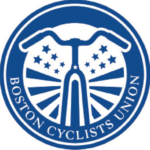City intent on Mass Ave bike lane, but challenges ahead

Union Rider reporter Patrick Kelleher-Callahan on usher duty, in front of a whole mess of bikes parked in front of Boston Public Library for the first meeting on a bike on Mass Ave. from Symphony to the Bridge.
But, after the city’s team explained that the parking was underutilized and bike crash data showed a need to improve safety, Boston Transportation Department’s director of planning Vineet Gupta felt positive enough about the prospects to count Mayor Thomas Menino as one of the lane’s top supporters.
“Our goal is to try and implement this bike lane by the end of this year,” said Gupta, toward the end of the meeting. But, he added, “The devil’s going to be in the details… We just want to make sure we accommodate everybody.”
Those details will be tricky, and the city may need our support during the process. The Union has learned that a handful of businesses have vocally opposed the lane in other meetings, citing concerns about losing customer parking and the ability to load goods in and out of their shops. And some institutions that actually do support the lane overall also have significant obstacles to overcome.
Soon, for instance, construction will begin for 168 Mass Ave. soon for Berklee’s new dormitory, to be built on the site of the current McDonald’s. This work is expected to continue for two years and presumably would involve a sidewalk detour into the street—right where the bike lane would be. The school also regularly loads and unloads school buses and chartered coaches at their performance center on that side of the street.
Loading problems could be mitigated by scheduling loading of retail goods for off-peak travel times, routing truck loadings through other access points to the buildings if they exist, or finding alternative places for temporary truck and bus parking. It may be, in the end, that cyclists will have to share the bike lane on the Northbound side with an occasional bus as it unloads passengers, but these concerns by themselves should not preclude a safer riding experience for cyclists.
But parking is another animal, and one that tends to get out of hand. Facts from Thursday’s presentation from the city, combined with some common sense and given to shop owners, will hopefully put it to bed.
It is often the first reaction from storeowners—who often commute by car or truck by necessity—to protect parking as if it were gold. They themselves use it and there is a perception—even in areas where pedestrians predominate—that all their customers arrive by car. Thankfully there are also some businesses out there that are beginning to realize that calmer streets might bring in the crowds better than a few parking spaces out front. And in this case there are two strong arguments that a business owner might see the sense in.
First, the vast majority of customers in this area are clearly pedestrians and transit users. Studies have shown that bike lanes help give the perception of calmer streets, and also that pedestrians are more likely to use calmer, safer streets. In before-and-after case studies in both Toronto and San Francisco, almost all business owners interviewed reported business was either the same or better after bike lanes were installed on their street. The underlying idea is that bike lanes may help make pedestrians feel more comfortable on a particular street, thus more of them come, and more pedestrians means more customers. Even a 1% increase in walk-by traffic is significant in areas where pedestrian traffic is already high, like it is on Mass Ave.
Second, the parking here is underused. On the northbound side of Mass Ave. where parking removal is proposed there are currently 71 parking spots. Only 54 percent of that parking capacity is used during the day, according to a parking study carried out by the Transportation Department, and only 24 percent is used overnight. The southbound side has more spots but similar usage, which means that folks who would no longer be able to park facing north, would most likely be able to find a spot facing south, and definitely all residents would be able to find a spot at night.
Thanks to everyone who heeded the Union’s call to show up to the meeting on April 14. Your enthusiasm for a bike lane on Mass Ave. was a great way to kickoff this planning effort by the city. The Union Rider, this website and our Facebook page will keep you posted on developments. Be ready to help out and let us know if you want to volunteer!

Where did you get those WILDLY fallacious parking figures?
I am glad that the Cyclist Union was invited, good for you! I manage a business on Mass. Ave. We were not invited. We were not informed that this was even happening. There was never a chance for us to issue an impact statement. My clients depend on public parking. A parking garage 2 1/2 blocks away will not do. They will not be able to carry their business to my shop. It would actually be dangerous for them to carry their business to me on the T. There was never a contingency for the businesses in this area. We were not invited.
In the story, right next to the as far as we know truthful figures you refer to, it clearly says they are “according to a parking study carried out by the Transportation Department.” It is our feeling that the city’s transportation engineers are professionals and act impartially in these matters.
If you have also had a team of professional transportation engineers carry out a study that disproves the one carried out by the city, please forward us the results. We would be very interested to see it.